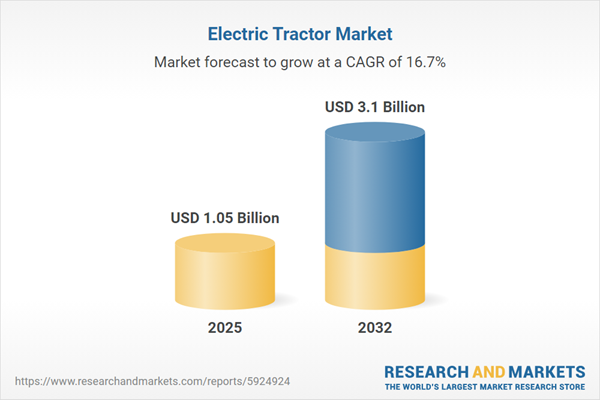Speak directly to the analyst to clarify any post sales queries you may have.
The electric tractor market offers senior decision-makers actionable strategies to advance sustainability, increase operational efficiency, and leverage digital and battery innovations. As the sector transforms, timely strategic moves will grant organizations a strengthened competitive position in a low-emission agricultural future.
Market Snapshot: Electric Tractor Market Insights
Global demand in the electric tractor market is accelerating, with robust growth rates fueled by industry-wide transitions toward clean-energy agriculture and smart technology integration. Regulatory incentives and a heightened focus on digitalization are enabling faster deployment of electric solutions in both large-scale and small-scale operations. Manufacturers and solution providers are channeling resources into enhancing product portfolios, building strategic alliances, and improving the resilience of supply chains. Adoption is on the rise across segments, as industry pressures highlight the importance of compliance and the pursuit of operational excellence in dynamic agricultural settings.
Scope & Segmentation
- Tractor Types: Battery electric tractors, utilizing either lead acid or lithium-ion batteries, enable zero-tailpipe emissions for multiple types of agricultural environments. Hybrid and fuel cell options satisfy needs where longer operational cycles or higher energy output are required.
- Power Output Classes: High-power electric tractors support operations for extensive agricultural enterprises, while mid- and lower-power models facilitate targeted fieldwork and ongoing land maintenance, addressing a broad spectrum of business models.
- Applications: Electric tractors are deployed not only in core crop production but also in orchards, vineyards, urban landscaping, public sector maintenance, and construction projects. This breadth of applications aligns with priorities for environmental stewardship and landscape management.
- Distribution Channels: Multiple procurement pathways exist through established dealer networks, direct sales to enterprises, and expanding digital channels. These approaches support organizations across both advanced and developing regions with flexible buying options.
- Charging Infrastructure: Ongoing investments include standard and rapid charging solutions. Such infrastructure supports operations in areas with power reliability constraints or high seasonal usage, delivering the flexibility necessary for uninterrupted service.
- Regional Coverage: The Americas, Europe, Middle East, Africa, and Asia-Pacific all drive market strategies, with countries like the United States, Brazil, Germany, India, China, and Australia shaping regulatory trends and influencing technology adoption patterns.
- Key Companies Profiled: Deere & Company, CNH Industrial N.V., AGCO Corporation, Kubota Corporation, Mahindra & Mahindra Limited, Monarch Tractor, Solectrac, Goldoni S.p.A., Escorts Limited, and TAFE Tractors and Farm Equipment Private Limited are advancing sector innovation.
Key Takeaways for Senior Decision-Makers
- Alignment with sustainability requirements enables consistent operations and readies businesses for stricter regulatory landscapes.
- Recent advancements in lithium-ion battery systems and more reliable charging infrastructure drive improved uptime, essential during peak agricultural workloads.
- Advanced digital management solutions enhance operational visibility and responsiveness, optimizing both resource allocation and performance monitoring.
- Diversification of manufacturing bases and regional assembly can minimize risks from international supply disruptions or shifts in trade policy.
- New business models—such as battery leasing and managed services—can address transition barriers, helping enterprises move toward electrified fleets faster.
Tariff Impact Assessment
Recent United States tariffs on electric vehicle components, batteries, and drive systems are compelling agricultural businesses to reevaluate sourcing and procurement methods for electric tractors. This regulatory trend is driving a heightened focus on localized manufacturing and modular product design, supporting competitiveness by boosting cost control and adapting to regional trade variability. Such approaches empower organizations to maintain reliable supply even under changing global conditions.
Methodology & Data Sources
Insights in this report are based on direct interviews with leading tractor and battery manufacturers, comprehensive analysis of regulatory frameworks, and detailed assessment of field performance metrics. Every dataset receives strict validation to ensure senior management receives clear, actionable intelligence.
Why This Report Matters
- Equips executive leadership teams with strategic perspectives on fast-moving technologies and evolving market dynamics to guide investment decisions.
- Supports manufacturers and providers in tailoring solutions that address complex operational and regulatory requirements in a demanding marketplace.
- Offers robust data for policymakers seeking to design effective infrastructure and sustainable agricultural policies suited for modern industry needs.
Conclusion
The electric tractor market is reshaping the future of agricultural technology and operations. Decision-makers who prioritize adaptability and informed strategy are well positioned to capture new opportunities as the industry advances.
Additional Product Information:
- Purchase of this report includes 1 year online access with quarterly updates.
- This report can be updated on request. Please contact our Customer Experience team using the Ask a Question widget on our website.
Table of Contents
3. Executive Summary
4. Market Overview
7. Cumulative Impact of Artificial Intelligence 2025
Companies Mentioned
The companies profiled in this Electric Tractor market report include:- Deere & Company
- CNH Industrial N.V.
- AGCO Corporation
- Kubota Corporation
- Mahindra & Mahindra Limited
- Monarch Tractor, Inc.
- Solectrac LLC
- Goldoni S.p.A.
- Escorts Limited
- TAFE Tractors and Farm Equipment Private Limited
Table Information
| Report Attribute | Details |
|---|---|
| No. of Pages | 184 |
| Published | November 2025 |
| Forecast Period | 2025 - 2032 |
| Estimated Market Value ( USD | $ 1.05 Billion |
| Forecasted Market Value ( USD | $ 3.1 Billion |
| Compound Annual Growth Rate | 16.6% |
| Regions Covered | Global |
| No. of Companies Mentioned | 11 |









